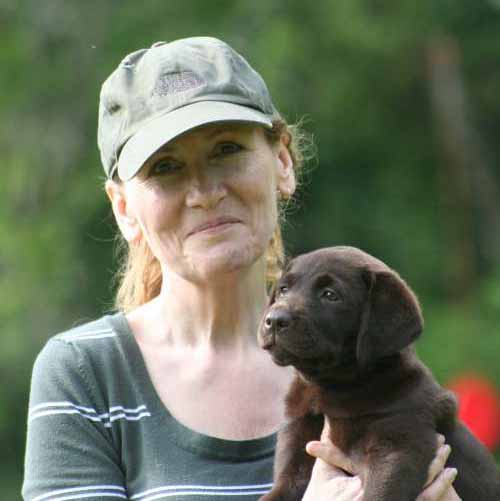Something that comes up from time to time in our training support group, and on our Facebook page, is the concept of time out. So I wanted to talk a bit about that today. About what time out actually looks like, from your point of view and from the dog’s point of view.

At first glance, a time out seems like a great way to teach a dog that they have done wrong without causing pain or fear in the dog. Positive training in action right?
Well, unfortunately, time out isn’t quite the positive training technique that you might be hoping for. And while there may be a use for it in some cases, in others, it’s only going to delay the point at which your dog’s behavior improves.
So we’ll look at what’s happening in behavioral terms when we give a dog time out. And at some examples of when and where time out might be appropriate. And when a different method might suit your purpose better.
What do we mean by time-out?
Time out usually involves confining a dog on their own for a short period of time. Either by crating them, or putting the dog in a playpen or another room. And specifically for the purpose of correcting unwanted behaviors.
Teaching a dog to separate for you and spend some time alone each day is an important part of a puppy’s education, but it is not the same as time out which is deliberately removing a dog from a situation in response to the way they are behaving at that time.
At one, time putting a dog in time out became quite a popular option to suggest to people that were struggling with disobedience or naughtiness in their dogs.
And there are two different reasons that someone might put their dog on time out.
One is in the hope that time out will make the dog think twice before repeating the naughty behavior. In other words, stopping the unwanted behavior and creating a better behaved dog
The other is to allow the dog’s emotional state to change. Usually in the hopes that the dog will calm down. Let’s look at stopping bad behavior first
Stopping bad behavior
To understand whether or not time out can help your dog learn to behave better, it’s worth spending a few minutes thinking about how it works. And about how dog’s (and all other animals) learn new behaviors
There are three outcomes to any action or behavior that your dog carries out. Either things
- Get better
- Don’t change
- Get worse
So either the dog enjoys time out (gets a benefit), or doesn’t care (nothing changes), or dislikes time out (things get worse for the dog).
In behavioral terms when things get better we call that ‘reinforcement’ because the dog is more likely to repeat those actions in the future. An example would be the dog that barks when it sees the cookie tin come out, and is given a cookie, so it barks more often in the future
And in behavioral terms, when things get worse for the dog, we say they have been punished. Which simply means that the dog is less likely to repeat those actions in the future. An example might be a dog that picks up a bee and get stung. They may avoid picking up stripey insects in the future.
As you can see, reinforcements and punishments can come from the environment as well as being provided by humans.
If the dog could care less about time out then things don’t change. And in this case, just like with punishment, the dog is still less likely to repeat their actions in the long run.
We call this extinction. Though in the short run, especially if the actions were rewarded in the past, the dog may repeat those actions even more for a little while in the hopes of getting those rewards to start flowing again.
We call this an extinction burst. And example might be when we stop giving cookies when the dog barks. For a while they may bark harder. But eventually they will stop barking when they see the cookie tin.
So does time out work?
In order to figure out if time out works, we first need to determine its impact on your dog. You need to ask yourself honestly how your dog feels about it. And that might depend on what is going on around your dog at the time.
If you are vacuuming for example and your dog hates the vacuum cleaner, then time out might be a relief to them. A reinforcement if you like, for whatever they were doing before time out happened. If the dog was chewing your table legs at the time, then you might accidentally reinforce that behavior if you give the dog a timeout while the vacuum cleaner is running.
If you are using time out as a punishment, albeit a very mild punishment, its only going to work if the dog really dislikes timeout AND if your timing is accurate. So that the dog knows exactly what the timeout is for.
And this is where most people fall down. Because time out cannot be implemented in an instant. It usually requires restraining the dog first and then walking or carrying them (or heaven forbid calling them) to the time out venue.
Immediately you have a problem because there is a very high chance indeed that the dog associates the grabbing, or the carrying, or the walking on a leash, with the time out, rather than the time out itself.
So you can see that you could end up with a dog that is being punished for letting you grab them or worse still (if you call the dog to the time out zone) the dog is being punished for obeying the recall.
I hope you can see why time out is a poor way to attempt to correct unwanted behaviors. For the most part it does not work. And if it works at all it will be because it is a punishment (something the dog finds aversive)
But what about using time out to change a dog’s emotional state? Isn’t that worthwhile
Changing emotional states with time out
We’ve all seen a puppy that is overwrought and exhausted and is going nuts with excitement. It’s not pretty.
In this state a puppy isn’t capable of learning anything, and badly needs to calm down. Putting a puppy in a comfortable crate with low lighting and low noise levels is usually helpful.
It enables the puppy’s arousal levels to come down to normal again, and when this happens most hyper puppies will quickly relax and go to sleep. In this situation time out is useful, though it’s worth bearing in mind in the future that it would be better not to let the puppy get into that state in the first place.
This isn’t going to work for every dog. It’s fine for a puppy that has good crate confidence and feels safe and relaxed in their crate. It’s definitely not fine for a puppy that is scared of being crated. Or an older dog that is suffering from separation anxiety, as the end result is likely to be a long screaming or howling session, and for the puppy, a soiled bed.
Time out is rarely what it seems
The general consensus among modern dog trainers is that time out is not a useful training technique. It’s not one that I use or recommend. Largely because it is mostly ineffective and very difficult to apply consistently or in a timely manner. And especially because there are much better ways to solve behavior problems.
Remember that we, as dog owners, don’t get to decide what is reinforcing and what is a punishing outcome, for our dogs. Punishments and reinforcements are defined by their impact on the dog and on the dog’s behavior
If your dog enjoys relaxing in their crate and does not enjoy their training sessions, then time-out in the crate is a reinforcement, not a punishment. And will increase the chances of the very behavior you are trying to eliminate, appearing in your next training session.
And if the dog hates their crate, but you don’t want to use punishment in training (and there are good reasons why you should not) then you are sabotaging your own training strategy
At best, time out is a bit like using a harmless but ineffective medicine. That medicine might not hurt you, but if it prevents or delays you from taking an effective medicine, there is potential for great harm.
In the same way, time out might not be as harmless as you think if it prevents you from actually training your dog.
Instead we recommend a good training program, and regular short daily training sessions that teach your dog how to choose good behaviors, listen to what you say to them, and obey basic cues. If your dog is over 12 weeks old you can check out Foundation Skills to get you started.

Free Training Tips
Get Pippa's free dog training tips delivered to your inbox

 4 Things That Need To Happen For Your Dog To Get Trained
4 Things That Need To Happen For Your Dog To Get Trained